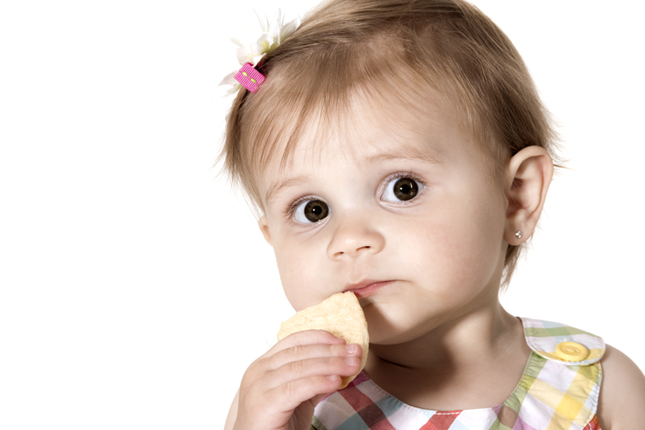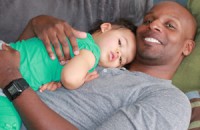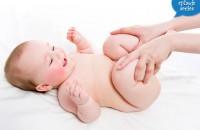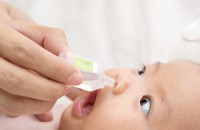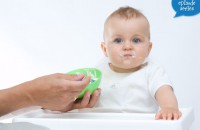Parent Savers
Baby-Led Weaning: Introducing Solid Foods to Your Baby
[00:00:00]
Please be advised, this transcription was performed from a company independent of New Mommy Media, LLC. As such, translation was required which may alter the accuracy of the transcription.
[Theme Music]
KC WILT: At around six months of age, we begin to introduce our babies to solid food. Most people buy or make puree fruits and vegetables. What if you could skip the puree stage and go straight to real whole food?
Baby-Led Weaning explodes the myth that babies needed to be spoon-fed and encourage to self-feeding and food exploration. What does that look like and how do you get started? We’re here with Gill Rapley and this is Parent Savers Episode 31.
[Theme Music/Intro]
KC WILT: Welcome to Parent Savers broadcasting from the Birth Education Centre of San Diego. I am your host, KC Wilt. Parent Savers is all about helping new parents for the baby years to the toddler years. So, download the free app – sign up for the free newsletter, like us on Facebook, send us an e-mail or call our hotline. This is your show. We want you to be involved.
We have amazing experts at our fingertips. So, shoot us a line and we’ll get your questions answered. We also have a new option of joining our Parent Savers Club and that’s where you can download the archive episodes and get exclusive contents and so much more. So, I’m a new parent. My son Carson is almost 23 months-old and I’m joined by two new parents in the studio.
SUNNY GAULT: Hi, my name is Sunny Gault. I’m the host and producer of our sister show Preggie Pals which is all about pregnancy. I’m 34 years-old. I have two children, two boys. One is about six months-old and one is over two.
JEN LONG: Hi, I’m Jen Long. I am 32. I’m a stay-at-home mom and a mother to my beautiful daughter Madison who’s nine months-old.
[Theme Music]
KC WILT: Before, we begin today’s show. Here is Amy Sorter with some eco-friendly tips for new parents.
AMY SORTER: Hello Parent Savers. I’m Amy Sorter, ecopreneur and co-founder of www.ecosavvymoms.com where you can find information for your family on-going green, saving money and looking great doing it.
Today, we’re going to talk about the importance of reducing your energy cost and saving money by following a few general rules. One of the biggest things I’d like to do is monitor my AC usage. Central air-conditioning can be the biggest energy user. I know it accounts up to 33% of your energy bill. What I’d like to do is keep energy cost down by regularly changing or cleaning the units’ filters and always setting it to 78 degrees between 11 AM and 6 PM.
Better yet, consider using ceiling or room fans instead of central AC to save up to 90% on your cooling cost. You’ll see a big change in your energy bill. Now, it’s important also to keep your kids involve in trapping the cold air in the house. Saving energy is keeping warm air out and not letting the cool air escape. To do so, make sure your windows and doors are line with weather stripping and don’t forget to remind your children to keep those doors closed while the AC is running.
Refrigerator can be another big energy user gobbling up 20% of the energy your home uses. Help it run more efficiently by cleaning the coils, making sure the seals are nice and tight and maintain the right temperature setting. Another thing I’d like to do is minimize my hot water usage. To save energy wasted by that hot water heater, I usually set the device to approximately 120 degrees. I wash my clothes and the dishes in cold water instead of hot water. Also, I have installed low flow shower heads and faucet aerators to help save water and other energy used.
Another important thing, dim the lights. Well, not literally but I’d like to do a save energy cost all year round with energy efficient lighting. CFL’s use 75% less energy and last up to 10 times longer than incandescent lighting. The last thing of course is, “Beware of energy vampires.” I know vampires are all the rage these days but energy vampires aren’t.
Some products like DVD players, office equipment, video games, phone chargers, those kinds of folks continue to drop power even when they’re turned off or in standby mode. If an electronic device has a glowing red or green light – chances are, it’s using phantom power and depending on how many of these energy vampires you have around your house, this wasted energy can really add up. Inexpensive gadgets like energy used monitors, power timers and smart strips can help reduce phantom power and lower your energy use by up to 15%.
For more information on how to reduce your energy cost and other parent friendly eco tips, visit www.ecosavvymoms.com or visit us on Facebook at Facebook.com/ecosavvymoms and don’t forget to make it a green day.
[Theme Music]
KC WILT: Today on Parent Savers we have Gill Rapley and she’s the author of Baby-Led Weaning and it’s teaching us what Baby-Led Weaning is and the benefits to skipping purees. Well, Gill we’re so excited to have you here. We’re calling you from the UK and we’re just so excited to talk about this topic.
So, let’s start off. What is Baby-Led Weaning? I know in the States we have a different word for weaning. Weaning for us is weaning off of breastfeeding or anything. So, can you explain that a little bit?
GILL RAPLEY: Okay, well let’s tackle the word weaning to start with. Actually, weaning is a whole long process that really begins with the first mouthful of anything that isn’t breast milk. So, although generally in the States, I mean a lot of other countries – it seems to be the end of breastfeeding. It can actually mean the beginning of that process which is way back because during that whole time the baby is gradually coming away from the breast of its main source of nourishment.
So, Baby-Led Weaning means not just letting the baby choose the end of weaning when and which the destination stops. But, I actually letting him choose the beginning as well – when to get started, how to get started and letting him do it himself.
KC WILT: Well, some paediatricians want babies to eat solids before six months they say or four to six months. Is Baby-Led Weaning applicable at four months?
GILL RAPLEY: Not really, because at four months babies aren’t able to sit upright and take food to their mouth and chew it and so on. The four to six months thing, it’s a little outdated now. There’s no need for a baby especially fully breastfeed babies but also babies that are on the regular formula to have solids before six months. And it seems like nature is telling us so that was okay. That’s why gate babies gain skills at around six months to reach and grab and take stuff to their mouth.
KC WILT: So, how does Baby-Led Weaning work?
GILL RAPLEY: It revolves around family meals time because it’s about treating the child and the respective member of the family from the right girl. So, the baby will sit up to the table with the parents and siblings in a high chair or the mom and dad’s lap. They’ll be offered food what everybody else is eating.
It means that the whole family needs to eat healthy foods that the baby can share without having salt and sugar and so on. Then the food is offered in a fully-shaped that the baby can grasp with their fist. At six months, they don’t have the time to grip. They can pick up small pieces of food – so, it would be in big chunks and sort of French fries shape.
KC WILT: But, if they are big chunks is that too big for them to swallow or anything? I know we’re going to talk little bit about choking in the last bit, in the next segment. What if they can’t grab it with their hand? They still don’t have that capability. They just kind of hit it with their hands?
GILL RAPLEY: Well, at six months, they should be grabbing. I think that’s where the four to six months seems commence – some babies will be ready slightly earlier, some slightly later. But around six months, they actually can grab and that’s the point. If none of the pieces kind of a size that will fit in their fist nicely without sticking out the top because what they can’t do is release it very easily from within their hand. So, at least it would be bigger than you’ve imagined. They chomp on it. They surely made bite off a small part.
Usually, when they first start – they’ll chew and it will fall out of their mouths because they don’t yet have the capability to swallow it purposefully. What they’re doing really it’s not about eating, it’s about exploring. It seems that what motivates babies to move on to solid foods is not hunger because at six months, their milk can provide over nutrition that they need. What is this discovering their world, finding out about it and then they discover have face that can work on new textures. They can practice the skills they need so that by the time they actually do need it of food; they are very capable of managing it.
KC WILT: Can you stick the item of the food in their hands and they eat it or the other question I have is, “If the food falls out of their mouth, do you put it back in or do you let them do it?”
GILL RAPLEY: It’s same for that nobody puts food in the baby’s mouth except themselves. Choking, I’m going to talk about it a bit later. But actually, one of the things that make choking more likely is as somebody else is in control of what goes in your mouth. You don’t have to think about, “How would you feel if you were being fed something to know that you have to kind of coordinate your breathing and everything to make it feel safe?”
So, it’s only the baby who should put stuff in their mouth. If it falls out, that would be a really good sign that they’re really not quite ready to swallow it. Probably, they can’t explore in safe and practice chewing. It just means that in terms of actually eating, they really don’t need it just yet.
KC WILT: How about putting in their hand and if they can’t grab it could you help them grab it, is that still okay?
GILL RAPLEY: Really, they can grab it. If they can’t, I should hold it out to them, offer it to them. But, you shouldn’t need to put it in their hand. If they can’t actually grab it out, they may not be able to pick it up off of the tray very easily. But, if they can’t grab it out of your hand then they’re really not ready.
If you would put food into a younger child’s hand – in some sort of reflex, they will grasp it but they don’t really know what they’re doing and so, they would be unlikely to be able to aim accurately for their mouth anyway. In six months, they can see what their hand like coordination is good – they can reach forward, they could grab. So, we could hold it up to them, offer it hand to hand.
If they have trouble of picking it up off the tray – we don’t need actually to put it in their hand for them in surfaces around it. If they can’t do that, they’re not ready.
SUNNY GAULT: Are there some babies that maybe just aren’t suitable for Baby-Led Weaning or would you just say that most babies should be able to do this?
GILL RAPLEY: The vast majorities of the babies can do this because this is just normal development. It’s picking up the toys and mom’s cellphone and so on and taking up to their mouths then they have the capability to do this; where it might not work for well is if the child have some sort of disability or a problem, an anatomical problem which chewing and swallowing with their throat.
Also some babies are born very pre-term may possibly need foods before they actually able to feed themselves. But, I think what we have to bear in mind that Baby-Led Weaning is about maximizing the baby’s skill and autonomy. So, even if the baby has a disability of something but means they can’t do this fully, there’s no reason why they can’t do it to the best of their ability.
I’ve had a lot of parents say to me that, “They won’t able to implement it fully because of the problem their child’s have but they feel grateful that they were allowed to maximize what their child could do for themselves instead of him being labelled of incapable.”
KC WILT: What if your child is on the skinny side? Supplementing with this food actually does help them increase their weight in everything else but yet, they’re not getting a lot in their mouth – is that, I mean I guess after controversy because food is supplemental up until the first year – what do you think about that?
GILL RAPLEY: The best and most easily digested food for baby is breast milk or a child of any age, that has got the most nutrients per ounce so, whatever. So, there is no better food if you need to put on weight then breast milk. Formula would be a twelve second. Any other food is not going to have the intensity that the kind of concentration of nutrients and calories that milk has.
One of the risks of starting solids early is that actually the baby’s will fill up on solids and lose appetite for milk. I’ve certainly seen babies start to lose weight if they start solids too early for that very reason. So, if the baby is skinny at around six months they need to eat up for what they’re meant to be or they need more milk. They don’t need solid foods.
JEN LONG: It’s interesting and Gill, I as a parent whose actually following the Baby-Led Weaning philosophy in feeding my daughter, our four month appointment we were told that our daughter is too skinny and that if she was ever sick – we were going to have to hospitalize her and put her on IV’s to get her better. So, we were told that we have to start solids right away. I knew that she wasn’t ready for it.
We definitely didn’t start until six months. I got a lot of pushback because here in US, this Baby-Led Weaning concept is pretty foreign. But, I was amazed. I’m amazed at how dextrous my daughter is now at nine months after feeding herself for three months with picking up foods. She tries all sorts of different things.
Our paediatrician’s asked us to introduce more fats because she is a very thin, tall and slender baby. Although, I breastfeed exclusively and she gets foods – they told us that we need to add some fattier foods in to help with that. What would you suggest for something like that?
KC WILT: Because ice cream just melts between the fingers when you pick them out.
GILL RAPLEY: I do couple of things that are really – one is that a lot of breastfeed babies are tall and skinny, that’s the way they were meant to be. We have a huge problem with obesity in the US and the UK currently and yet, we are still worrying about the kids that don’t weigh a lot. If they have energy and they’re healthy, then they obviously the way they were meant to be.
Children manage their own appetite, especially children who’ve been breastfeed. They know went to stop eating. If we fill them up with calories, they’ll just eat less. If we fortified the food with fat, they’ll probably eat less fully to make out for it because they’re in control of their diet. The only way to fatten up a skinny child who is healthy and eating according to an appetite is to force them or persuade them or control them into eating more. We all know that the problems that can lead to with the relationship with food.
So, in forms of fat – it’s important to perhaps state that babies under two don’t need low fat food, they need full fat milk, cream cheese whatever. But, beyond that actually add fat is a bit of an outdated concept.
JEN LONG: That’s kind of what I thought. I wanted to ask. I want that affirmation first because that’s what we definitely how we are. We definitely aren’t pushing things on her that she doesn’t want or really need. So, it’s a great – I’m actually jumping up and down my chair right now.
GILL RAPLEY: I probably should added slight caveat. I actually am not a nutritionist or dietician and I know that what they sometimes have strong views on this. But, they tend to – unlike with paediatricians, their concern is mainly with sick children. They don’t see the children who are well and running around and fine. Thank you very much.
This is from my background. It’s more of a behaviour thing. I honestly believe that forcing kids to eat, things they don’t want to or when they don’t want to or more than they want to is a recipe for problems later.
KC WILT: I have a friend of mine and she does purees and then her sister-in-law does Baby-Led Weaning. So, when they were all the family – the mother-in-law was harping. Pick up that food. He can’t grasp it because they follow Baby-Led Weaning and their child wasn’t able to grasp the food. So, the child wasn’t eating very much.
What about those concern capabilities? What if they don’t have them right at six months? Can you help your child? Can you put food in their mouth or put food in their utensil that put in their mouth? What are ways to help them get the food or you just go, “Okay, well you didn’t eat the food. We’ll just toss it and try it the next meal?”
GILL RAPLEY: I think we have to ask ourselves why we’re so desperate to see baby’s eating food. That they really – we said earlier, “They really don’t need great quantities in this stage.” Certainly, between say six months and nine months – if they eat last constantly with solid food, they’ll eat less milk. So, actually their nutrition isn’t benefiting at all. They need very small quantity on top of their milk.
It’s fine to offer them say, “A pretty loaded spoon.” That’s right, but again – they need to be in control of what goes in their mouth and how much and so on. A pinch of grip is that someone forcing a grip and that’s quite important to picking up very small thing but then maybe, a safely reason why babies of say six months actually can’t pick up peas and raisins and so on.
The bigger pieces of food, they’re much easier for them to handle. They get more advance, they learn. There’s no harm in putting food in front of the baby and letting him try, letting him learn. We’d say rice or peas or whatever. But, if he can’t do it – then there’s probably a reason why. We need to start with pieces sort of two and three inches long and about, like a chunky French fry, a thick French fry to pick up that sort of shape. Most of that she will pick up in that sort of shape. Something very like that, green beans are great, asparagus.
It’s quite in defined foods, to that sort of shape and mimic that with the other foods. So, bell peppers, potato, and carrot – they can all pick up into the right short of shape and those babies can manage easily.
JEN LONG: I’ve learned that I don’t even modify what we’re eating as parents. I make a healthy meal and she gets food off of like she has her own plate of our food. So, we had a Chicken Tortilla Soup the other day and she actually had soup on her tray. Now, she didn’t have all the liquid. It was quite messy but she had pieces of chicken. I just love Baby-Led Weaning. It’s amazing
KC WILT: I’ve read it on web on your site and other places, you just kind of be [unclear] right?
GILL RAPLEY: Absolutely, it is messy. But then, that sort of learning is all about – it’s really fascinating with some daycares and nurseries have messy play for kids. But, they don’t let them make a mess when they eat. I think we really mix ourselves up.
SUNNY GAULT: Well, because you don’t play with your food – that’s what you’re taught growing up.
GILL RAPLEY: Yes, I think we have to really understand what young children doing when they’re playing. They’re not playing as in for amusement like you and me. They’re playing for learning and discovery. It’s not the same meaning of play. It’s important that they find out how to pick up a strawberry without squeezing it for example. How do you know that if you’ve never actually work it out for yourself? So, this is important learning time.
What parents tell me is that, “Actually, if their babies learn very, very quickly because they’re giving lots of practice.” Every day, they can have a go whenever everyone else’s eating. So, they very quickly stop being messy and they’re very capable and tidy eaters when they’re in their early toddlerhood.
KC WILT: Well, great. This is a great conversation. Thank you. So, we’re going to talk more about choking and the big pieces that go into the mouth in a minute. So, we’ll discuss this and more when we return.
[Theme Music]
KC WILT: We’re back on Parent Savers. We have Gill Rapley, author of Baby-Led Weaning and she’s teaching us about Baby-Led Weaning and what it is in the benefits to skipping puree. What types of food should we not cut up and let them gnaw and suck on and what do you cut up and how small?
GILL RAPLEY: Many babies can manage a variety of shapes and sizes quite quickly. I don’t [unclear] food that we should not cut out.
KC WILT: A piece of steak or something like that – if you’re doing meat to your child, do you cut it up in small bits or do you give them a big old piece to let them just kind of gnaw on it?
GILL RAPLEY: You’ll give them a big piece, a big chunk that they can hold in their fist. There’s no – if you would, you can cut it out small and they will be able to pick it up simple. So, cut it big to start with and then gradually as they get mash out it, it can be smaller. Meat can be tricky to prepare for babies, a little bit of steak they can have a good old suck and gnaw on it. But, if you would cook beef really long and slow then it becomes quite crumbly sort of doing beef and they can manage that easily.
Chicken, easy – ground beef and made into home-made patties or burgers, they can manage that. So, we’re talking about finger foods – size the sandwich size that sort of thing and French fry sized. We can also do smaller things and they’ll surprise us by how quickly they learn to pick them up. But, we need to try and get off thinking the other way around. We work from big streak to small, not the other way around.
KC WILT: I find this conversation helping a lot with my mom’s friends. They can go, “What about the choking? I get so worry, he’s choked on this or he’s choked on that when he’s eating.” How does that look different for Baby-Led Weaning kids?
GILL RAPLEY: Okay, I found it’s important to say, “There’s no guarantees, anybody can choke at anytime – adult or child.” But, we do have situations that children are really, really at risk of choking. I think we have to look at the sort of things that make choking more risky. One is something – somebody else puts something in your mouth for you. One is using a sucking movement to get the food in and babies do a sucking movement when they’re spoon-fed.
The idea that kids learn choke if we spoon-feed them is just not correct. It’s not born out infectious. When you take something off of a spoon of the young maybe, you tend to suck it in like I would do with a fix him a plate of soup. It comes but when we take in food when we bite it first, we do something different.
There are lots of foods who wouldn’t normally use a spoonful. Even if we do – like our breakfast cereal, we’re taking it in a different way. Start puffing the front of their mouth which is where we chew it. We’re not sucking it to the back straight away. If you try and suck in, let’s say administer only food – you’re going to choke. So, we need the child to be in control and let them if they’re sitting upright anything that is according to problem will tend to fall back out. What they do quite often is to gag at first which is like a sort of vomit-y, retching kind of movement. That’s very common because it’s triggered very far-forward in the mouth of the young baby.
I think this has been kind of explored identified, but it seems to me that this is actually a way to help them learn how far to push something back on. It actually project two things. You’ll trigger a gag long before the food anyone near the airway.
KC WILT: So, when they’re gagging – they’re not necessarily choking?
GILL RAPLEY: No, exactly.
KC WILT: Okay.
GILL RAPLEY: It’s a distant movement. It’s a movement designed to bring the food forward for more chewing. It’s look as if they’re going to vomit and some babies do bring up a bit of milk that they previously had saved. But, it doesn’t seem to bother them.
KC WILT: You get worried as a parent seeing your child like that.
GILL RAPLEY: Sure, it’s really scary for parents but it really doesn’t bother the baby. It is you just have to take a deep breath and count to five and they’re fine. They just carry on eating as if nothing happened.
Very occasionally, they will actually have a – we don’t have a very good word for this. It’s choking but it’s not real choking. When they cough and splatter a bit, like you and I do if we get a cram call that can happen to sometimes. But again, if they’re sitting upright – they’re going to be fine. They’re going to sort it out themselves.
True choking is extremely rare and very unlikely except with foods like whole nuts. We would prep, cut out grapes or cherry tomatoes just to be able to safe side. But, it’s extremely uncommon and it tends to happen with just putting other things in their mouths not necessarily with food.
Interestingly enough, a lot of parents tell me that when they’re Baby-Led Weaning become so close – they seem to be much less interested in putting things in their mouths and they could run their peas. Maybe because they’ve learned what side of the [inaudible 00:23:47], what isn’t.
SUNNY GAULT: Can you get back and forth between Baby-Led Weaning and purees or is it more – okay, you got to stick with one or the other because you’re going to confuse the baby?
GILL RAPLEY: I don’t think babies are seriously as if they’re confused of we think. It’s about a different approach not just about consisting of another way to caught up your food. It’s fine to alternate between soft foods, runny foods, puree foods and stick food, pieces of food – as long as the baby knows he is the one in control.
What we don’t want to do is alternate between allowing the baby to feed himself and insisting on feeding him both. That would be fair and they would get a little, they might get confused that they would get crossed about that.
KC WILT: That’s what I was wondering because sometimes do they just kind of – the parent feed him the puree because you got to go and you got to hurry and you don’t have the time to let them to sit and explore but then, other meal times – there’s the time they sit explore you wouldn’t recommend that.
GILL RAPLEY: Sometimes, they’re tolerant and they’ll go with it but others, I have to taste of what’s it like to be independent autonomous and they really not keen to be fed by someone else – but, somehow at a happier certain sometimes in days for that to happen. But Baby-Led Weaning is a whole different approach to share a meal times and respecting a baby and trusting a baby – so, it’s actually very difficult to suddenly decide not to do that between at certain times of certain days.
KC WILT: I go out and about. My son’s now almost two and a lot of people will go, “It’s great. He feeds himself. He doesn’t rely on you to feed him. At a young age, I didn’t worry about choking and a lot of food in front of him.” He did a lot of this I guess Baby-Led Weaning. But, we did do purees and we started out as purees and my son likes it. He eats a lot.
So, whether I’m feeding him and giving shovelling in his mouth because we have to go or at dinner time – I lay an assortment of food in front of him. He’s happy just because there’s food being presented and he wants to eat it. So, I don’t know it’s one of those situations where I guess I’m on the fence with both of them. I do both things. That was incorrect per say. Should I have done one or stick to the other?
GILL RAPLEY: There’s no correct or any correct. I mean parenting is just a nightmare isn’t it, feeling about being guilty about this and that. The thing is, “If you have even embrace Baby-Led Weaning then you have a respect for your child which means that yes, they are days when you want to eat porridge and to eat more quickly.”
A lot of babies are very happy to be fed sometimes. But, the point is you’re not going to push them to finish the plate for whatever in the way that the children need to be forced into eating more than they wanted. You’re going to still have that underlying respect for your baby and understand when he’s saying, “No, this is enough.” So, in that sense – you’re not really alternating. But, you’re just asking him to corporate with you with a different way some days and that’s fine because he can choose to do that.
JEN LONG: I started just recently we pick some of the pouches of the puree pouches because there’s so easy when you’re out and about and I know she’s hungry and she doesn’t want breast milk because she just ate and she’s trained to be completely and she doesn’t want that anymore but she wants more food. I’ve always wondered – I started to wonder, “Am I confusing her by giving her these pouches to eat?”
GILL RAPLEY: I don’t think she thinks there’s kind of either-or. It’s just, “Okay, we’re going to have this today are we?” Does she’s happy with it? That’s fine, no problem.
JEN LONG: I always think the difference is to, is not, “I’m not squeezing it for her. I just hand her the pouch and half of the time it ends up all over her but she’s getting better.”
GILL RAPLEY: That’s baby led. It’s not a problem with the puree. It’s the problem with the spoon-feeding and the forcing of food on babies. That’s really the difference. But, that’s no different than offering her some walnuts to dip something into. There’s lot of different consistencies with food. It’s not the consistency of food that’s the issue. It’s whether or not the baby is being allowed to make the choices.
KC WILT: What I’m also hearing is that, “If you do choose to spoon-fed purees – even then, listen to your baby’s cues. If they purse their mouth shut, they turned their head. You listen to that and not finish the jar or the bowl.”
GILL RAPLEY: Absolutely, where is in the past moms were told – well, you have to make them eat. You have to play games. You have to trick them. You have to put a bit of nice food on top of the nasty food. All those things we would play games and trick for babies. Then, we wonder why we were traps full and suspicious of food are things that with the recipe from them.
JEN LONG: Is there an order of safe foods that we should be doing with our daughter and with Baby-Led Weaning to support their growing digestive system?
KC WILT: Well, yes. Just like in purees you do some foods first and then your next foods – do you still follow that?
GILL RAPLEY: I think we should remember that, “Most of that applies, are applicable to babies being started on foods for four months when actually what we would be saying then was – they’re really not ready for this. We have to check carefully.”
If you wait until six months, you really don’t need to check in that sort of way. If there are allergies in the family, then you want to be careful about certain foods. But, in general they are much more robust at six months. Their digestive system is ready for these other foods. That’s the whole, that’s why Baby-Led Weaning works so well at six months.
KC WILT: So, broccoli at six months – you don’t need to wait till nine months?
GILL RAPLEY: No, absolutely not.
JEN LONG: It’s amazing to me since I do this when I go out with friends or with my family. Especially with my mom, she handed my daughter a carrot to gnaw on and I have pictures of it. I get phone calls from my mom – she’s like, “She’s gnawing on a carrot, you’re going to choke your child.” I laughed because she hasn’t choked yet. She’s nine months-old. She’s been doing this for three months now. We haven’t had a single problem. She will pick up pretty much any food we give her.
I had a burrito one day and she took a bite from my burrito. We had pizza and it’s amazing – curries, I can’t imagine giving just a bland puree food to her now.
GILL RAPLEY: I think we have to remember that a lot of our experiences of baby’s choking is because they have to have because they haven’t been allowed to experiment and then in their own time, some of the moment they will first ready to.
Certainly, I’ve seen babies of – let’s say eight to nine months who are allowed to feed themselves for the first time of that age, having being puree fed up till then. They just stuffed their mouth like a little hamster like they doesn’t seem to know when to stop because they don’t kind of learn about the chewing phase. They just get food in and swallow it. Eat and swallow. Eat and swallow and they don’t know there’s a middle bit. So, they just stuff away.
Apart because this gag reflex to the point of no slightly back then, they are inclined to push things to fall back and make themselves couch and splatter. So, it seems that by starting them practicing when they first they are able to bring food to their mouth – helps them learn gradually and gently instead of being thrown in the deep pen when they’re already eating quantities.
KC WILT: Well, great. Thank you so much. This has been a great conversation. Thanks to Gill Rapley for helping us learn about Baby-Led Weaning. If you want more information, go to our today’s show on our episode’s page on our website or visit www.rapleyweaning.com You can also buy her book Baby-Led Weaning on our Amazon bookstore on the website.
[Theme Music]
DOYIN RICHARDS: Hello Parent Savers. It’s Doyin Richards for the blog Daddy Doin’ Work; it’s all about being a new dad. Today we’re talking about, “Being dads with daughter.” Now, subconsciously – they are some dads out there who want to have a son. I love raising a daughter. I think it’s the coolest thing in the world, having a little girl that I’m totally responsible for and being the primary role model in her life – male role model that is.
I’ve learned so many things when it comes to raising a daughter like for example, the clothes that girl’s wear – I have no idea what jeggings were prior to having a daughter. Jeggings, I guess their jeans and leggings put together? Listen, I’m a champ now. I can buy jeggings like it’s going out of style. I don’t think it’s going out of style anytime soon.
Also, I have a strong affinity towards hello kitty. I just love it. Actually, I put a hello kitty decal on my keychain because my daughter loves hello kitty so much. Also, some of the things that I call her – are unbelievable like snow cones, love-love, angel’s sauce, cat in a cute face. I mean who does that? Do you think that it’s the dad and their daughter does for you? It’s a craziest thing ever but it is such a wild ride. I love it so much and if we’re lucky enough to have a second kid, I’m kind of rooting for being a daughter.
Thank you so much for listening and if you have an idea for returning topic that you like to talk to us about – please e-mail me to my blog at www.ideaofworks.com or post your ideas on my Facebook page. Thanks a lot and I’ll see you in the future. Bye.
[Theme Music]
KC WILT: That wraps up today’s episode. We love to hear from you. If you have any questions for our expert about today’s show or the topics to be discussed – call our Parent Savers hotline at 619-866-47-75 or send us an e-mail through our website www.parentsavers.com or Facebook page and we’ll answer your question in our upcoming episode. Thanks for listening to Parent Savers, empowering new parents everywhere.
[Disclaimer]
This has been a New Mommy Media production. Information and material contained in this episode are presented for educational purposes only. Statements and opinions expressed in this episode are not necessarily those of New Mommy Media and should not be considered facts. Though information in which areas are related to be accurate, it is not intended to replace or substitute for professional, Medical or advisor care and should not be used for diagnosing or treating health care problem or disease or prescribing any medications. If you have questions or concerns regarding your physical or mental health or the health of your baby, please seek assistance from a qualified health care provider.
End of Audio
[00:34:00]
